SIBE 2022: Importance of Water Management to Prevent Schistosomiasis
By Adi Permana
Editor Adi Permana

BANDUNG, itb.ac.id – One of the webinars organized at ITB FTSL’s SIBE 2022 is “Sustainable Water and Sanitation Infrastructure for Public Health” on Tuesday (08/03/2022). It was led by Prof. Michael Templeton, a professor from the Imperial College London who has expertise in public health engineering.
Prof. Michael explained about Schistosoma, a type of worm that resides in tropical and subtropical regions. It is a parasite that attacks most organs in the human body, causing acute and chronic illnesses.
To prevent public infection and transmission of disease, WHO has drafted a number of preventive strategies to deal with each phase of Schistosoma's life cycle. For instance, people are administered medicine to kill the adult Schistosoma that may live inside their bodies while sanitation is improved in certain areas so that the eggs do not enter the waters. Other efforts that can be done are by exterminating the snails that act as carriers of the worms. Treating water bodies with chemicals can also intensively kill all Schistosoma in it.
Of all methods mentioned, water management is more effective because it involves contact with water and directly affects the rate of infection and transmission. The cleanliness of water is crucial in the long-term plan to reduce Schistosoma infection yet the treated water must remain safe for use. Thus, the “WASH for Schisto” program aims to lessen the contact with contaminated water to stop schistosomiasis.
Prof. Michael suggested several options for minimizing contact with the polluted water. The first was to establish facilities and shelters that collect rainwater to fulfill all water needs. Another option is to treat the water so that it is safe to use by people.
An alternative is direct water management, which is more complex and dangerous. Hence, personal protective equipment like gloves and boots are required to reduce direct exposure while handling. Maintenance of water management facilities and community campaigns are also some of the ideas to minimize contact with water.
One of the study projects done to search for the correlation between water and Schistosoma is the WISER (Water Infrastructure for Schistosomiasis-Endemic Regions) program. This massive, multi-disciplinary project is funded by the UK government and partners with institutions from Tanzania and Ethiopia. Engineers, parasitologists, synthetic biologists, and anthropologists banded together to find the best solutions by assessing water contamination levels and detecting Schistosoma in the waters. Currently, these researchers have experimented with chlorine and sand-based filtration to lower the Schistosoma population.
Despite the WASH scheme being good enough to tackle schistosomiasis, Prof. Michael reminded the audience that there are a few downsides. According to him, WASH is only effective with active participation and support from the community. If the majority has access to clean water but they still use contaminated water for social or cultural reasons, the WASH program and clean water provision will be obsolete. Therefore, the WISER project encourages education and cooperation in the community via campaigns.
“We need to be careful in considering the organism's life cycle and its disease transmission path to choose the most relevant kind of water and sanitary installations on-site,” he stated. “Its coverage, service, and interventions may contribute to the sustainability and effectiveness of the plans to achieve adequate public health.”

Reporter: Ruth Nathania (Environmental Engineering, 2019)
Translator: Ruth Nathania (Environmental Engineering, 2019)

.jpg)

.jpg)
.jpg)
.jpg)


